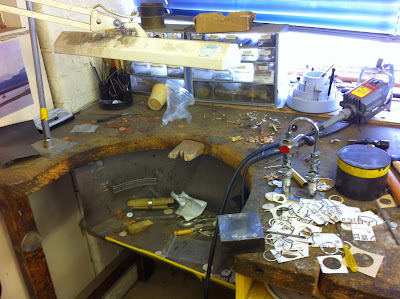This week we took a trip
North of London to visit our cufflink manufacturer and put into work our new
designs for the up and coming season. This is always a very exciting process,
particularly because we love to try and challenge the manufacturers when it
comes to creating our new and innovative ideas.
We were ever so kindly given a tour of the factory to see
how our initial ideas and sketches become finished items through a series of complicated
and time-consuming procedures.
Depending on the complexity of the design and manufacturing
method, a wax model may first be made in order to understand the technicalities
of the construction and to finalise shape and size. These will then be used to
create a mould for the cast styles.
Another method of production is stamping; these styles begin their lives
here…
Each design with all its intricate detail is carved out onto
a piece of lightweight metal, before being transferred to a ‘die’. Each
cufflink style will have its own die; a heavy metal block that is used to stamp
the design into sheets of metal.
 |
| ‘various cufflink dies’ |
 |
| ‘archive of thousands of dies’ |
This requires enormous force so the die is clamped into
place using a massive vice and the sheets of metal are stamped to produce small
individual pieces of metal each containing a perfect replica of the design.
The
metal stampings are then taken through to a workshop where a team hand trim
away the excess metal. This is called
“clipping” and they may also, depending on the design, even add etching detail
by hand!
We
then took a peak into the enamelling room. Enamelling is done by fusing powdered
glass at an extremely high temperature, usually between 750 and 850°C to metal.
The powder melts and fills the hollows in a design that has been stamped out of
metal. When it is cooled it hardens into
a smooth and durable glass like layer.
 |
| Baths of the chemicals used in the plating process before enamelling. |
 |
| Enamel colour palette |
 |
| Production team hand enamelling cufflinks |
Enamel is applied liberally, often overfilling the detailed
metal work and even covering the design. After the enamelling stage the
cufflinks are taken to be linished. This
process strips back the excess enamel leaving the metal design showing
though. At the same time the metal is polished
and the enamelled cufflink is left looking beautifully clean, smooth and shiny.
Penrose cufflinks available online here.








